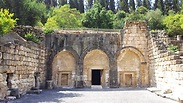
Beit She'arim declared World Heritage Site
UNESCO announces Mishnaic period village with its 30 burial caves is to be ninth Israeli World Heritage Site; Rabbi Yehuda Hanasi, Mishnah's chief redactor, resided and is buried there.
UNESCO's World Heritage Conference on Sunday declared the national park at Beit She'arim in the lower Galilee a World Heritage Site.
Beit She'arim was a prosperous settlement during the period of the Mishnah's redaction (1st to 3rd centuries ACE) and the site includes 30 burial caves where rich people and scholars of the period, including the chief redactor of the Mishnah, Rabbi Yehuda Hanasi, were buried.
Beit She'arim is the ninth site in Israel to be recognized by UNESCO as a World Heritage Site. Of the 21 members, 17 countries voted in favor - India, Turkey and Senegal - and four countries actively opposed - Lebanon, Qatar, Algeria and Malaysia.

Beit She'arim was considered to be the regional grain storehouse during the Mishnaic period. According to the historian Josephus Flavius, these were the barns of Queen Berenice, the sister of Agrippa II, who ruled the country under the Romans in the first century AD.
Rabbi Yehuda Hanasi lived most of his life in Beit She'arim, only spending the last 17 years of his life in the not-far village of Tzipori. In his last will and testament, he asked to be buried in Beit She'arim, which turned the village during the 3rd century ACE into the Jewish necropolis (city of the dead) of its time.
Many wanted to be buried next to Rabbi Yehuda as an alternative to burial in Jerusalem, where it was forbidden to be buried due to Roman edicts issued at the time, when Jerusalem was a Roman colony by the name of Aelia Capitolina.
The push to include the site on the list of World Heritage sites was led by Israel's ambassador to UNESCO and the OECD, Carmel Shama-Hacohen, and the the Foreign Ministry's department of international organizations.
Once declared a World Heritage Site, the possessing state and authority obliged to maintain the site and its environment, protecting it from development that does fit its spirit and character. Such a declaration leads to an increase in the number of tourists who visit the site.
The Israel Nature and Parks Authority said Sunday that the site is the oldest and most densely populated cemetery in Israel, and one of the most crowded burial sites in the Roman world, similar to the catacombs in Rome.
"This is the most important ancient Jewish cemetery, and it contains a wide variety of architectural burial styles, containing a varied wealth of Classical Oriental Roman art, combined with folk art, with hundreds of inscriptions in four languages - Hebrew, Greek, Aramaic and Palmyric."
The Authority's chief archaeologist, Dr. Zvika Zuk, said after the announcement: "Beit She'arim is a moving testimony to our ancestors which has almost no equal anywhere else in the world. When visiting Beit She'arim's necropolis, one feels the beating heart of the Jewish people."
Last year, Beit Guvrin was declared a World Heritage Site. Other sites previously added to the prestigious list were the Nahal Me’arot Nature Reserve, the Baha'i holy sites in Haifa and the Western Galilee, the Incense Route and its Nabatean towns, the biblical tels of Megiddo, Hazor and Be'er Sheva, The White City of Tel Aviv, Masada and the Old City of Acre. The Old City of Jerusalem and its walls were the first Israeli heritage site declared by UNESCO, in 1981.
Shama-Hacohen said, "This amazing achievement of unprecedented support proves that Israel initiates positive moves decisively and wisely and does not just defend and push back, and that it can reap fruits even in problematic forums such as UN organizations."
Over the weekend, UNESCO declared Al-Maghtas, the site of Jesus' baptism in the Jordan River, a World Heritage Site. Jordan painted it as a great victory for them in light of Israel's attempts, they argue, to appropriate the site.
Jordan has in its territory several World Heritage sites, such as Petra, Wadi Rum and Um er-Rasas (Kastrom Mefa'a).
Ahiya Raved and Roi Kais contributed to this report.











